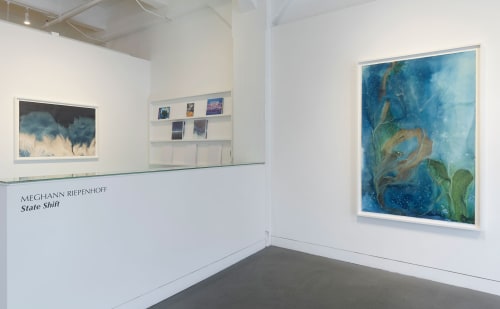Meghann Riepenhoff: State Shift
“The physical nature of my work, where photography-based media come in contact with rain, waves, wind, and wintry environments, is a call to be in closer contact with our environment, in a time of deep separation between humans and our ecosystems,” Riepenhoff has said. In issuing this call — both to herself and to viewers — the artist invites us all to consider the personal and collective shifts we might make to preserve our shared home. State Shift emerged from difficulty and explores sites of climate devastation, but is rooted in the possibilities of transformation and hope. “Hope,” the author and activist Rebecca Solnit has written, “is a belief that what we do might matter, an understanding that the future is not yet written.”
State Shift coincides with Second Nature: Photography in the Age of the Anthropocene, a major group exhibition opening at the Cantor Arts Center at Stanford University in February 2025 that features Riepenhoff's work. Originating at the Nasher Museum of Art at Duke University, Durham, NC, Second Nature will travel to the Anchorage Museum, AK following its presentation at the Cantor.
-

-

-

-

-
 Meghann RiepenhoffDay 51: Prussian Blue pigment + lake water + butterfly pea flower + commercial pigment + mica, 2024Unique Dynamic Cyanotype25 x 28 inches, framed
Meghann RiepenhoffDay 51: Prussian Blue pigment + lake water + butterfly pea flower + commercial pigment + mica, 2024Unique Dynamic Cyanotype25 x 28 inches, framed -
 Meghann RiepenhoffDays 46-49: mushroom spore ink + Prussian Blue pigment + tears + lake water + snow and sun + freeze and melt + time, 2024Unique Dynamic Cyanotype46 x 92 inches, framed
Meghann RiepenhoffDays 46-49: mushroom spore ink + Prussian Blue pigment + tears + lake water + snow and sun + freeze and melt + time, 2024Unique Dynamic Cyanotype46 x 92 inches, framed -
 Meghann RiepenhoffDay 263.1: Waters of the Americas: Florida Department of Environmental Protection #8092, 2024Unique Dynamic Cyanotype28 x 62 inches, framed
Meghann RiepenhoffDay 263.1: Waters of the Americas: Florida Department of Environmental Protection #8092, 2024Unique Dynamic Cyanotype28 x 62 inches, framed -
 Meghann RiepenhoffDay 287: mushroom ink + Prussian Blue pigment + algae pigment + commercial pigment + ginkgo chlorophyll + Rattlesnake Lake + Moncton boulders, 2024Unique Dynamic Cyanotype70 x 46 inches, framed
Meghann RiepenhoffDay 287: mushroom ink + Prussian Blue pigment + algae pigment + commercial pigment + ginkgo chlorophyll + Rattlesnake Lake + Moncton boulders, 2024Unique Dynamic Cyanotype70 x 46 inches, framed



























